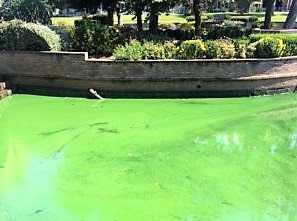Blue-green algae is the common name of a group of cyanobacteria commonly found in many lakes and ponds. Blue-green algae can kill fish, and is the most noxious form of aquatic growth that we deal with here in North Texas. Its growth is first recognized as a “pea soup” green appearance to the water. As its lifecycle progresses, the density of the growth thickens and can turn shades of yellow, white, and eventually aquamarine blue. Dense mats of algae most often accumulate on the downwind side of infested ponds.

These algae blooms are dangerous!
Blue-green algae blooms that occur in freshwater lakes and ponds can be directly toxic to fish and wildlife. The blooms produce a toxin that can kill fish and even mammals if ingested in large amounts. These toxins are released from the blue-green cells when they die and rupture. Blue-green algae can also kill fish indirectly by causing oxygen levels to drop below the threshold for fish survival. This can be caused by exaggerated fluctuations in daily oxygen levels or by a sudden “crash” or die off of the bloom. Sudden die offs can be the result of natural environmental conditions or improper chemical treatments. Blue-green blooms are not only toxic, but they also emit pungent odors that resemble sewage and/or natural gas.
Blue-green algae blooms can happen at any time; however, they are most common from mid-summer to fall in this area. The bloom is fueled by phosphorus and nitrogen. Both of these nutrients are common to urban watersheds due to extensive landscaping and fertilization programs. Blue-green blooms often appear overnight and there is no sure fire way to predict when it will happen. However, they are very common during the summer after a heavy rain event followed by a few days of direct sunlight. The best way to prevent these noxious blooms is to reduce nutrients within the watershed.
Treating Blue-Green Algae
Treating blue-green algae with commonly used algaecides is extremely risky and should only be done by a qualified biologist. These blooms are highly susceptible to algaecides and over-treatment can lead to a large scale toxin release or oxygen depletion. In fact, we do not recommend any form of chemical treatments during extended periods of very hot weather. The only exception to this rule is when the bloom is isolated to a relatively small area of the lake or pond.
Safer control methods include supplemental aeration, beneficial microbe enhancement, and application of nutrient deprivation products. All of these attack the cause of the problem rather than the symptoms of the problem. When used in conjunction, these have all proven to be effective at reducing the density and duration of blue-green algae blooms in ponds that we routinely manage.
